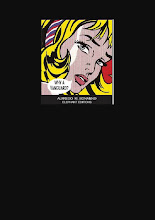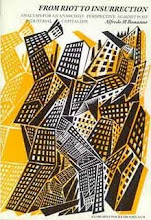From 'Armed Struggle in Italy 1976-78' Elephant Editions
In order to dispel any ambiguity which might arise, I should like to make it clear that when I speak of armed struggle I am not basing myself on artificial divisions imposed by bourgeois laws where the throwing of dozens of molotov cocktails runs the risk of not being considered a situation of armed struggle by some comrades.
It is not the technical instrument we use that qualifies an action as violent or not, but rather its perspective in the confrontation with the class enemy. To employ armed struggle means essentially to be ready to respond to State violence and exploitation blow for blow at every level. It means passing from the purely defensive phase to one of attack in order to strike the enemy’s centres of organisation and repression. At the same time it must be capable of indicating to all the exploited where the true enemy is concealed, and that it is possible to strike it, it is not indistinguishable nor invulnerable. The latter is all the more important in an advanced phase of social democracy. Here the State is trying to draw the proletariat into its own logic to have them identify with the adversary through the mechanism of consensus and the co-management of exploitation, and at the same time use terror by exhibiting a strong apparatus of criminalisation and repression. This situation can be seen today not only in the German Federal Republic, but also in Italy and all the other areas of advanced capitalism.
Different methods and choices can obviously exist within the revolutionary struggle, not all of which can be shared from an anarchist viewpoint, but I shall speak of this later.
I also hope to avoid the ambiguity of certain positions which, after maintaining that they do not object to taking up the question of armed struggle in itself, confuse the issue with such statements as: “the present situation (...) does not impose the need for clandestine armed struggle which inevitably ends up demanding all the energies of the militants involved.” (Rivista Anarchica, March, 1977, p. 12)
Above all I should like to point out once again how the whole question becomes abstract through such reasoning. Armed struggle comes to be seen as something cut off from the rest of revolutionary activity, as a separate, purely “technical” and military phase which would steal time and energy from... one doesn’t know the rest. Besides, it seems to me that such arguments distort the problem by qualifying armed struggle with the adjective “clandestine” in a way that seems inevitable, negative and degenerating. Given the fact that armed struggle is always in itself illegal, it does not seem to me that clandestinity can be made to coincide exclusively with one’s own choice, but rather that it is an eventuality to be borne in mind and does not fatally imply the creation of a vanguard/mass relationship of the Leninist kind. On the other hand, to come back to the present situation who can say that the comrades who carry out a certain type of action (for example the ambush in Pisa on the doctor responsible for the assassination of comrade Serantini), which can certainly be defined as clandestine, are themselves “clandestine” and on the contrary are not carrying out a normal open practice of militancy?
Whv violence?
There seems to be reasonable agreement among the great majority of comrades concerning some fundamental problems: that violence is not the spontaneous expression of our own free will, but it is the scientifically organised violence of oppression and exploitation implemented by the State which constrains us as revolutionaries to reply with an opposing, liberatory violence if we do not want to bow down to the beating of our employers. Ours is always therefore a defensive violence, which does not mean that it limits itself to warding off the enemy’s blows.
If what I have just said is true, it seems clear to me that in reality the problem of when armed response is justifiable or inevitable does not exist. We would be short-sighted or opportunistic if we could not see beyond the more or less democratic and permissive veneer with which power covers its homicidal essence. Whatever form it takes, the exploitation of man by man always merits a reply in the perspective of its violent destruction. It is not a question of deciding who “fired first” in order to know whether our defence is “legitimate” or not: for centuries the State has “fired first”, and our deaths do not only come about in the streets under the bullets of the police, but also in the factories, the prisons, asylums, ghettos, shanty towns, the clandestine abortion clinics, and the mines all over the world. If it were a question of a moral problem there would not be the need for even a minute’s discussion in the face of the hundreds of comrades, of exploited, assassinated daily and whose blood cries vengeance to our conscience.
But the problem is not only a moral one. Our rage, our revolutionary will, must always be accompanied by lucid reasoning which allows us to conduct the struggle in the most consistent and effective way possible. This is not to say that offering oneself to be slaughtered on the alter of the martyr renders service to the revolutionary cause. The revolutionary act, we all know, is a collective act that presupposes a high level of generalisation in the consciousness and the will for radical change in social relationships in a communist direction. And it is here that most criticisms raised by comrades against the practice of armed struggle are aimed today. They say: we are not living in a pre-insurrectional situation; the masses are controlled by the reformists and certain actions are not understood.
To this objection one could reply that the revolutionary movement should not always limit itself to carrying out the “popular will” which often risks transforming itself into something intangible or of disputable interpretation. Alongside the “cultural” work of propaganda and the diffusion of the revolutionary perspective, the anti-State movement should also know how to put their affirmations into practice, especially in a situation where the ideological hegemony of the reformist forces has lulled the consciousness aqnd will of popular struggle or where they have been suffocated by State repression. Ideological dissertations and theoretical propaganda are not enough to shift the power relations that really exist. They must express themselves in actions where increasingly wider strata in the class of oppressed can recognise their own real needs.
This perspective might, at the limit, be identified with the so-called exemplary deed which certainly requires careful reflection on the relationship between active minority and social situation, and on the choice of objective. But this, it seems to me, cannot be reduced to referring to a “glorious” historical past that we want to contribute to.
In the face of the present situation, the argument of the exemplary deed seems to me to be limiting and inadequate. It seems to me that we find ourselves before something qualitively different. Today certain actions are carried out by more or less specialised and appropriately organised minorities, but they are the expression of a movement which cannot be simply discarded as minoritarian on the basis of mere mathematical calculation. In saying this we are not only referring to situations such as those in Bologna and Rome on March 11 and 12, where actions of armed certain “clandestine” actions operated and claimed by organisations which have made a declared choice of armed struggle, such as the Red Brigades, the NAP or the miriad of new names which appear day after day.
The anti-institutional movement and violence
In the present situation it is no longer possible to say that actions such as armed clashes with the police, attacks on the centres of exploitation or the physical persons of some of the better known persecutors of revolutionary militants, are only the will and fruit of the painstaking efforts of a handful theoreticians of the professionals of clandestinity, separate from the mass.
Today, when the Montedison electronics factory, or the Luisa Spagnoli shops, or the doctor who approved the assassination of Serantini are struck, this only adds to the demands and levels of consciousness of a movement which is something more than a simple conglomeration of groups, collectives or tiny parties. It is a movement which includes large sectors of those who have been pushed to the margins of society, “non-guaranteed” students, women, those in insecure jobs, and less numerous but no less important, sectors of industrial workers, service workers and technicians, etc. A movement which has singled out, perhaps instinctively, perhaps not clear in its complexity, but certainly with precision, the enemy present not only in the repressive apparatus of the State and the governors most in evidence, but also in the new reformist bosses of the trades unions.
The line of refusal and opposition to capitalism and the reformist lie is becoming concrete through certain actions that are the patrimony of the movement. This is emerging from struggles that, although not carried out by the majority, certainly belong to the mass.
Accustomed for years to having to count on a practice of impotence in a movement which has been trying to go beyond the level of “opinion”; accustomed to dealing with problems typical of a conscious minority more or less isolated from the real movement, many of us find ourselves uncomfortable in this situation. This explains the obvious difficulty in centering on real problems and the tendency get lost in quite marginal research which has already been surpass by the real level of the struggle.
For example, the difficulty that appears through the repetition of the obvious but useless ideological “distinction” based on the classic argument: the Red Brigades are Marxist-Leninist and we are anarchists, therefore there exist insurmountable differences between us. This question could even get to the heart of the problem if it were not closed within the abstract contestation of the two tendencies seen as being static and dogmatic, instead of analysing the concrete problem of translating these theoretical choices into practice.
And here we could consider the problem of how the Marxist-Leninist conception (but perhaps more Castroist than Leninist) of the armed party translates itself into a practice of professionals of clandestinity chosen in advance, which is the main criticism I should make of the Red Brigades.
The decision that certain comrades should constitute the armed wing of the class recreates a situation of separation which can become the main cause of errors in evaluation made by those comrades who, closed within the logic of the specialized minority, often find it hard to relate their own actions to the political level and the needs of the movement. It is one thing for a workers’ nucleus to decide upon the punishment of a foreman, a fascist or the sabotage of a plant, and entrust the execution of this to a restricted number of comrades (for obvious reasons of security, efficiency, etc.). It is another, completely different, for a restricted number of comrades absent from the situation and with little or no links with it, to decide to carry out the same action.
Besides, within the logic of the latter, such armed groups are not formed on the basis of a natural process of “distillation” where the more politically mature and those with a greater capacity for types of actions become involved in the more advanced struggles. Instead this comes to be based on quite personal idealistic choice, a method that does not seem to me to be right, even within a vanguardist logic, which, moreover, I do not share.
The right road is not therefore, in my opinion, the armed party of military specialists, but should be instead that of widening the area of revolutionary struggle against the State. This is so, not because it has been decided by a handful of intellectuals, but because the anti-institutional movement that has developed cannot withdraw or procrastinate on positions already conquered to wait for better times, but must try to go ahead. Experience shows that the fascistic social democratic State is not disposed to concede the minimum of space that is not snatched from it by force.
Why the movement is going forward
At this point the problem to be faced is not so much that of rendering the actions of armed struggle “comprehensible” to the movement so much as that of the relationship between the revolutionary movement which is beginning to emerge all over the country (and which precisely because it is revolutionary contains contradictions that need to be faced without obstruction), and the rest of the proletarian movement where the reformists still manage to exercise their own hegemony. It is mainly a question of the workers who have been guaranteed relative well being from the struggles of ’68, etc., paid for by their integration into the logic of work, exploitation and the State, and who are passing through a critical time.
The capitalist crisis at world level has on the one hand eliminated the system’s margins of recuperation, preventing the unions from being able to play the role of containing and reabsorbing struggles as they were called to do in ’68/’69. At that time revolutionary tendencies manifested themselves in a period that was still one of expansion, where capital still had areas in which to negotiate. Today the system has very little to concede to wage earners in exchange for their implication in the process of fascisization of society.
Cracks have opened in the reformist-controlled worker’s movement. A certain disorientation has spread, a generalized discontent, but which is finding it hard to transform itself into the will for social change, or to identify the enemy clearly. A precarious equilibrium has been established between workers and their managers, which an attempt must be made to shatter. We know that the marginalised and the “guaranteed” have in reality a common enemy, but the latter lack an awareness of whom those enemies are.
The movement must go forward to shatter the reformist equilibrium. It must demonstrate with its struggles that there exists a pole of anti-capitalist and anti-State aggregation, which can become a point of reference even for those who are guaranteed nothing but exploitation.
Translated from “Anarchismo”
skip to main |
skip to sidebar

Some writings of Alfredo Maria Bonanno in English, or almost

Alfredo Bonanno was arrested on October 1st 2009 in Greece, accused of concourse in robbery. With him, anarchist comrade Christos Stratigopoulos.
Here are a few translations and part translations of a small portion of Alfredo's writing. This is a work in progress, many of the translations are as yet incomplete. Open links to find more of Alfredo's work.
Alfredo Bonnano Released
Nov. 22 Alfredo Bonnano was sentenced to 4 years imprisonment (which practically means that with the time served so far and the fact that he is over 70years old HE IS RELEASED
Christos Stratigopoulos (who took responsibility for the action)
was sentenced to 8 years and 9 months with the Greek law will probably be released at the end 2011
BY ANY MEANS NECESSARY
LINKS
click on any of these labels to read text
- "Community" sickness
- 1981 - Editorial
- A Critique of Syndicalist Methods
- A few notes on Sacco and Vanzetti
- A few notes on the revolutionary movement in Italy
- A little man in Singapore
- A million jobs
- A question of class
- Affinity
- After Marx autonomy
- Albania Laboratory of Subversion (Introduction)
- Anarchism and the national liberation struggle
- Anarchists and action
- AND WE WILL ALWAYS BE READY TO STORM THE HEAVENS AGAIN (Against amnesty)
- ANTI-INSTITUTIONAL MOVEMENT
- Are we modern?
- Armed Joy
- ARMED STRUGGLE. SOME REFLECTIONS.
- Autonomous base nuclei
- beyond syndicalism
- Beyond workerism
- But what is the imaginary?
- Class War
- Comiso - Organizational document of the self-managed leagues
- Considerations on illegality
- Dissonances (Introduction)
- Elephant Editions 1986
- Excluded and included
- Farewell to claiming
- Feral Revolution (Introduction)
- FICTITIOUS MOVEMENT AND REAL MOVEMENT
- For an Antiauthoritarian Insurrectionist International - Proposal for a debate
- From riot to insurrection
- From the centre to the periphery
- Good technology
- Guerilla Extraordinary
- Habits and idols
- Hegel
- I know who killed chief superintendent Luigi Calabresi
- Illegality
- Illness and capital
- Informal organisation
- Insurrection
- Internationalism
- Introduction to Sabate
- Introduction to Anarchism and Violence
- Introduction to Bratach Dubh English edition of Malatesta's Fra Contadini
- Introduction to Insurrectionalist Anarchism
- Introduction to Strange Victories
- Introduction to The Conquest of Bread
- Involuntary aspects of voluntary work
- Let's destroy work
- LET'S DESTROY WORK. New introduction
- Let's keep our feet on the ground please
- Lightening Conductors and Stand-ins - more shots of non-news
- Lightning Conductors and Stand-ins
- Lightning Conductors and Stand-ins (cont.)
- Locked up
- Looking forward to self-management
- Loss of language
- More on internationalism
- National Liberation Struggle
- nineteen years on
- No more crises
- Non-news about drugs
- Non-news about racism
- Ode to the Uniform
- On Feminism
- One's life on the line
- Order and chaos
- Otto Ruhle (Introductory Note)
- OUR ROLE IN THE PRESENT CONFLICT
- Palestine mon amour
- Pantagruel anarchist review
- Pinelli
- Prison and Prisoners’ Struggles - Introduction
- Propulsive Utopia
- Quality and the factory
- Restructuring Capital and the new democracy
- Revolution - Violence - Antiauthoritarianism
- REVOLUTIONARY VIOLENCE
- Science and the social revolution
- Self-management
- Severino Di Giovanni in Argentina 1923-1931 by Osvaldo Bayer
- Social banditry
- SOME NOTES -
- Space and Capital
- Stirner
- Stop the City? From information to attack
- Strategy and Methods
- Streamlined production
- The "end" of the crisis
- The aesthetics of anarchism
- The anarchist tension
- The area of autonomy and the anarchist movement in Italy
- The armed wing of science
- The Cruise missile base at Comiso can be prevented
- The ethical bank
- The insurrectional project
- THE LANGUAGE OF TECNICS -
- The logic of insurrection
- The moral split
- THE NECESSARY DESTRUCTION -
- The priority of practice
- The refusal of arms
- The revolutionary project
- The revolutionary struggle
- The significance of an insignificant event
- The struggle for self-managed social space
- The tyranny of weakness
- The whole and the part
- The young in a post industrial society
- Theory and action
- Towards anarchist antimilitarism
- TOWARDS THE GENERALISATION OF ARMED STRUGGLE
- TRANSFORMATION IN THE WORLD OF WORK AND SCHOOL -
- TRUTH -
- Unemployment in Italy - How come everything doesn't explode?
- Untitled
- Violence and non-violence
- What are anarchists
- What can we do with anti-fascism?
- Why a vanguard?
- Why Insurrection
- World domination in a few words











